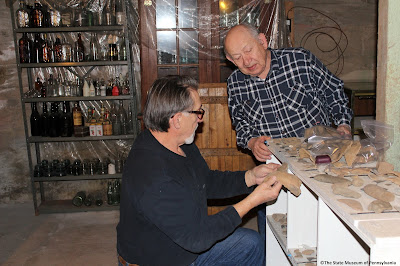March 20th officially heralded in the beginning
of spring with the spring equinox, and we have been granted our first glimpses
of warmer weather. The equinox is the point at which the earth’s axis tilts
neither towards or away from the sun, it is the midpoint between summer and
winter and the date when the day and night occupy equal amounts of time. Around
the world, cultures have long marked this occasion as the end of winter and a
sign that warmer weather is on its way. It is a time for celebration as the
scarcity of winter fades into the welcome warmth and abundance of warmer months.
The indigenous people who lived in this area before the arrival of Europeans
were no different, marking the seasonal round by the movement of the sun, the
phases of the moon, the constellations in the night sky and by observing the
changes in their environment.
In order to track the movement of the sun, ancient people
built structures and utilized natural features which, either through imaging or
sighting, tracked the movement of the sun from winter solstice to equinox to summer solstice and back again as the rising sun moves across the horizon from north
to south. Sighting calendars use alignments of natural or man-made features to
indicate the direction of the rising or setting sun, while imaging calendars
create specific shadows or rays of light at certain times of the year. For a
people who were far more connected to their environment than we are today, the
movement of the sun and the accompanying changes were part of the rhythm of
life, dictating when to hunt, gather plants or sow fields. Today we use dates
on a calendar, but these ancient solar calendars are, in many cases,
functioning just as they have for hundreds, if not thousands of years.
An example
of an imaging calendar, a rectilinear area adjacent to this circular motif on
Little Indian Rock in the Lower Susquehanna fills with light as the sun crests
over another section of the rock on the equinoxes. The light first fills one
portion of the box, bisected by a natural crack, before expanding to fill the
remainder of the shape. Serpent motifs elsewhere on this rock sight to the
rising sun on the equinoxes. (photo by Melanie Mayhew)
With the passing of time, the indigenous cultures of this
area celebrated their respective festivals and ceremonies, although often it
was not the sun’s position that was used for the timing of these rites. The
Iroquois and Delaware relied upon other events such as environmental changes,
phases of the moon and constellations present in the night sky to determine the
correct time for their ceremonies.
The Delaware, as recorded by Frank Speck, use the position
of the stars and the moon to inform them of the proper time to gather medicinal
herbs, plant crops in the spring, and the time at which animals breed and fish
move up stream. The gathering of materials for basket-making was also tied to
the seasons, and in order to produce durable hides, animals must be killed at
the right time of year. This determination of activities based on the seasonal
round is pervasive and is an integral part of the indigenous lifeway. Star-lore
was used to inform tribal members of environmental changes and the proper times
for such activities as leaving for or returning from a hunt.
A feature of Iroquois, Delaware and other indigenous
cultures is the naming of each lunar cycle based on environmental changes
occurring at that time. The moon names may change by group and location and
reflect cultural and regional variation in indigenous culture. The lunar names
give a clue as to the activity that occupies the central role for that time of
the year.
The names
of the moons as described in the book Travels in New France. Moon names
varied by region and cultural group.
The cyclical nature of time and observances of the sun’s
position have been recorded in the Middle Atlantic in ethnographic records, and to
a lesser extent in village patterning and recovered artifacts. Whatever the
season, there was always some significance to the time of the year as we travel
around the sun and through the seasons, once again arriving at spring.
References:
Snow, Dean
1996 The Iroquois. Blackwell Publishers, Malden.
Speck, Frank G.
1931 A Study of the Delaware Indian Big House
Ceremony, Vol II. The Pennsylvania Historical Commission, Harrisburg.
Stevens, Sylvester K. et al (Eds.)
1941 Travels in New France by J.C.B.
Pennsylvania Historical Commission, Harrisburg.
Sturtevant, William C. (Ed.)
1978 Handbook
of North American Indians, Vol. 15, Northeast. Smithsonian Institution,
Washington D.C.


















